
Martin H[e]inrich Carl Lichtenstein was a German physician, explorer, botanist and zoologist. He explored parts of southern Africa and collected natural history specimens extensively and many new species were described from his collections by European scientists.

Carl Ludwig Willdenow was a German botanist, pharmacist, and plant taxonomist. He is considered one of the founders of phytogeography, the study of the geographic distribution of plants. Willdenow was also a mentor of Alexander von Humboldt, one of the earliest and best known phytogeographers. He also influenced Christian Konrad Sprengel, who pioneered the study of plant pollination and floral biology.

Zoysia is a genus of creeping grasses widespread across much of Asia and Australia, as well as various islands in the Pacific. These species, commonly called zoysia or zoysiagrass, are found in coastal areas or grasslands. It is a popular choice for fairways and teeing areas at golf courses. The genus is named after the Slovenian botanist Karl von Zois (1756–1799).
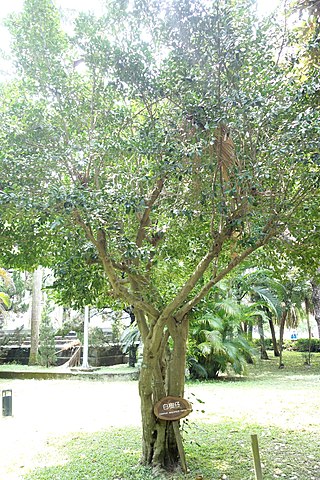
Suregada is a plant genus of the family Euphorbiaceae, first described as a genus in 1803. It is native to tropical and subtropical regions of Africa, the Indian Subcontinent, China, Southeast Asia, Australia, and certain oceanic islands.

Bridelia is a plant genus of the family Phyllanthaceae first described as a genus in 1806. It is widespread across Africa, Australia, southern Asia, and various islands of the Indian and Pacific Oceans.

Libidibia coriaria, synonym Caesalpinia coriaria, is a leguminous tree or large shrub native to the Caribbean, Central America, Mexico, and northern and western South America. Common names include divi-divi, cascalote, guaracabuya, guatapana, nacascol, tan yong, and watapana (Aruba).
Johann Gerhard König was a Baltic German botanist and physician who served in the Tranquebar Mission, India before joining service under the Nawab of Arcot, and then the English East India Company. He collected natural history specimens including plants, particularly those of medical interest, from the region and several species are named after him including the curry tree (Murrayakoenigii).

Asparagus asparagoides, commonly known as bridal creeper, bridal-veil creeper, gnarboola, smilax or smilax asparagus, is a herbaceous climbing plant of the family Asparagaceae native to eastern and southern Africa. Sometimes grown as an ornamental plant, it has become a serious environmental weed in Australia and New Zealand.

Habenaria, commonly called rein orchids or bog orchids, is a widely distributed genus of orchids in the tribe Orchideae. About 880 species of Habenaria have been formally described. They are native to every continent except Antarctica, growing in both tropical and subtropical zones.

Dactyloctenium is a genus of Asian, African, and Australian plants in the grass family. There are about 13 species in the genus in the world, in which 3 are known to occur in India. A common name for the plants is crowfoot grasses.
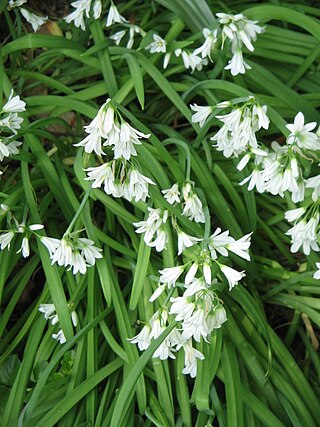
Allium triquetrum is a bulbous flowering plant in the genus Allium native to the Mediterranean basin. It is known in English as three-cornered leek, in Australia as angled onion and in New Zealand as onion weed. Both the English name and the specific epithet triquetrum refer to the three-cornered shape of the flower stalks.
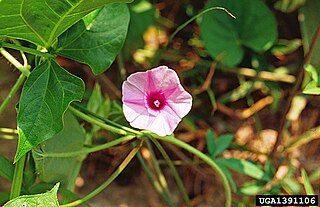
Ipomoea heptaphylla, sometimes known as Wright's morning glory in the United States, is a species of morning glory. It is incorrectly classified as I. wrightii in American publications, but is incorrectly known as I. tenuipes in Africa and India. It is an annual or short-lived perennial vine which climbs using twining stems, and has pink or purple flowers. The leaf shape is somewhat variable, with individuals possessing compound leaves palmately divided into five leaflets, and lanceolate-leaved individuals occurring in neighbouring populations. The name heptaphylla actually means 'seven-leaved'. This plant has a very extensive distribution, from Texas and adjacent states in the southeastern USA to Misiones in northern Argentina, the Greater Antilles of the Caribbean, India, Sri Lanka and East and Southern Africa. Despite its wide distribution it is uncommon throughout its range. The rediscovery of the presence of the species in India after an absence of over half a century was published in 2014. The species appears to favour dry subtropical to tropical habitats.

Karl von Zois zu Laibach was a Carniolan amateur botanist and plant collector. Von Zois was described as a "country gentleman". He is best known today as the namesake of zoysiagrass, which was named by Carl Ludwig Willdenow in 1801. The bellflower Campanula zoysii is also named after him.
Johan Peter Rottler was a French missionary and botanist, most associated with the Danish Mission in Tranquebar and later Vepery, Chennai in southern India.
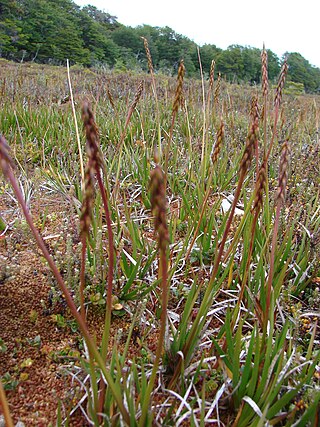
Tetroncium is a genus of plants in the Juncaginaceae described as a genus in 1808. It contains only one known species, Tetroncium magellanicum, known from a few sub-Antarctic islands: Tierra Del Fuego, Falkland Islands, and Gough Island. The plant got the name magellanicum because the original description was describing the sample found near the Strait of Magellan.

Acacia willdenowiana is a shrub belonging to the genus Acacia. The plant is also commonly known as wattle grass, grass wattle or two-winged acacia. It is native to the south west of Western Australia.

The climbing liana, sometimes a shrub, Mallotus repandus, is a species of plant in the Euphorbiaceae, or spurge, family. It is native to Tropical and Sub-tropical Asia, Wallacea, New Guinea and Queensland on the Australian continent and New Caledonia.
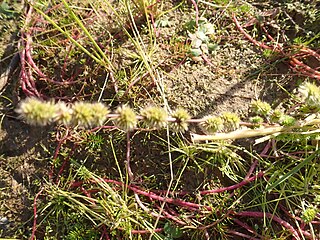
Elytrophorus spicatus is a small plant in the Poaceae family native to Africa, the Indian subcontinent, south-east Asia and Australia.
Astartoseris is a monotypic genus of flowering plants belonging to the family Asteraceae. It only contains one known species, Astartoseris triquetra.
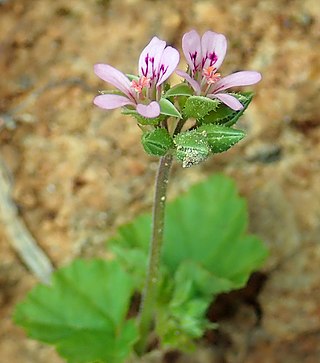
Pelargonium inodorum, commonly known as wild pelargonium, is a flowering plant in the family Geraniaceae. It is grows in New South Wales, Queensland, Tasmania, Victoria, New Zealand. It has scented leaves and mostly pink flowers.

















